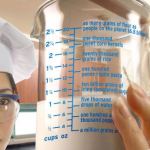Retrotechnology and steampunk
For Christmas, my friend Vanessa got me this wonderful Equal Measure measuring cup by Fred. One side gives measures in cups and ounces, along with the equivalent quantity of various granular substances (five thousand drops of water, as many grains of flour as people on the planet). The other side gives metric volumes, alongside biological volumes (half a human brain; enough corn oil to fuel a biodiesel car for three miles, amount of table salt in a large human).
If I were still teaching physiology, I'd totally be using this in lab! As it is, I may have to convert a recipe or two into T. rex…
Is it a small torpedo? A thermos? A shiny handbag? Who cares, it's adorable!
Metal purse by Frank Strunk, who has also created some really uncomfortable-looking "industrial chic" outfits and men's ties. Uh, I'll just take the purse, thanks.
Via Haute Macabre via Coilhouse.
Coming through SFO last weekend, I encountered a wonderful exhibit of classic science fiction toys entitled "Out of this World! The Twentieth-Century Space Invasion of American Pop Culture." Tired and sick as I was, it made me wish I had more time to kill in the airport!
The show opened with two monolithic silver robots assembled of found objects by sculptor Clayton Bailey:
Check out Bailey's gallery of robots here.
The robots were followed by display upon display (all in acid 50s aqua, naturally) of vintage board games, toys, costumes, primitive robots, remote control aircraft, cap guns…
No, that's not a phalanx of nuclear power plants in Harlem - it's a futuristic housing concept proposed in 1964 by visionary Buckminster Fuller and his student Shoji Sadao. The 100-story residential skyscrapers would hold 45,000 occupants each. Fuller and Sadao also proposed a two-mile wide dome over midtown Manhattan, which would minimize energy loss and maintain a protected, artificial climate inside - the better to preserve the city's aging cultural artifacts.
Have fun at New York's millionth-comment party at the Delancey tonight, Sciblings and readers. I can't be there, but if I were, I'…
Bibliodyssey just published an outstanding collection of illustrations depicting the development of the microscope. I recently saw these antique microscopes at the National Museum of Health and Medicine, and I enjoyed trying to match my photos with the engravings.
This ornately decorated microscope was made by Christopher Cock (~1665), designed by Hooke and used by him in preparing Micrographia. (NMHM, "The Billings Microscope Collection," 1974) Note the similarity to the microscope in this plate from Hooke's seminal book Micrographia (via Bibliodyssey):
I love the NMHM's period…
Third Eye
Wayne Martin Belger
This is one of the most strangely compelling artworks I've encountered recently: a pinhole camera made from a 150-year-old skull.
Wayne Martin Belger's Third Eye is a human skull with a tiny hole drilled in the traditional location of the mystical "third eye." The pinhole allows light to enter the cranium and expose photographic film.
The cranium is opened and the film accessed through an elaborate, gothic set of findings crafted from jewelled aluminum, titanium, brass and silver. The effect is steampunky, but also reminiscent of the decorative metalwork used…
The brand-new Device Gallery is hosting a group show called "Fantastic Contraption" featuring artists like H.R. Giger and Christopher Conte. The show opens this Saturday, July 19, from 6-9 pm - check it out if you're in La Jolla!
Steam Insect
Christopher Conte
Via dark roasted blend.
It looks like the British Museum has a good chance of keeping this medieval brass astrolabe quadrant on public display in the UK. The export license for the device has been delayed until June, giving the BM a chance to raise its 350,000-pound selling price - which should please retrotechnophiles and Chaucerians alike.
The astrolabe originated with the Greeks, but was popularized by Islamic astronomers and became widely used across Europe. The British Museum already has several, like this pretty one I saw last summer:
Brass astrolabe with silver inlay, 1712
British Museum
So why do they need…
The following is another post from the "old" bioephemera (originally published June 18, 2007).
Last weekend I discovered Seattle's Gas Works Park. By accident. And ended up on a tour through the derelict gasworks - led by the park's designer, Richard Haag. The structures are fenced off, so I got the impression this was an unusual privilege. Fortunately my camera's battery wasn't completely exhausted, though I was torn between taking photos and listening to Haag recount his efforts several decades ago to convince the city that this industrial site could be bioremediated. Among his persuasive…
Michelangelo's Creation of Adam
From Paluzzi et al., Journal of the Royal Society of Medicine, 2007
For a few years, Nature Reviews Neuroscience stuck to a humorous theme in its cover art: everyday objects that mimic brains. A dandelion, spilled wine, a rock, a cave painting: if you know what features to look for, a surprising number of things resemble brains. We are a species that sees faces on the Martian surface and the Moon; we're very good at pattern recognition, and it's probably evolutionarily better for our brains to err on the side of "recognizing" something that isn't there, than…
